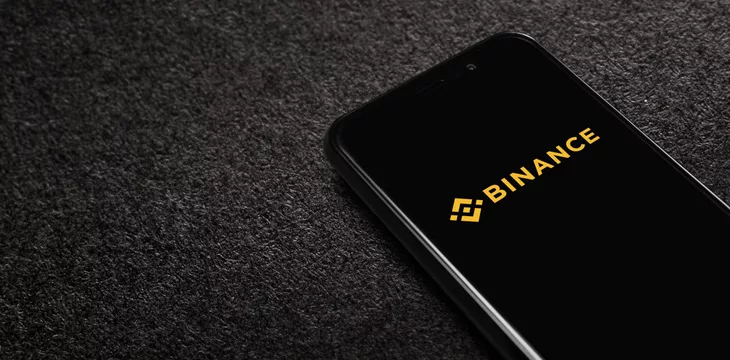|
Getting your Trinity Audio player ready...
|
Binance claims to have sold its Russia-facing operations to a new day-old digital asset exchange, prompting suspicions that Binance founder Changpeng ‘CZ’ Zhao remains the man behind the (iron) curtain.
On September 27, Binance announced that it had “entered into an agreement to sell the entirety of its Russia business to CommEX,” an exchange that launched only the day before. The company behind the new exchange is the Seychelles-registered CommEX Holding Ltd. CommEX claims to be “backed by top-tier crypto VC.” However, none of these top VCs apparently feel all that strongly about making their support public.
Virtually no other information about the new business or the individuals behind it has been disclosed, either by Binance or CommEX. Binance insisted that, while the deal’s financial details would remain a secret, “Binance will have no ongoing revenue split from the sale, nor does it maintain any option to buy back shares in the business.”
However, CommEX’s website—there’s no app yet—shares a lot of Binance’s DNA, to the point that one could call CommEX a Binance’ white label’ site. Moreover, CommEX’s terms of service are almost identical to Binance’s, and both cite Hong Kong law as the ultimate arbiter of any customer disputes.
There’s also the suggestion that the two exchanges are sharing liquidity. CZ himself is promoting that Russian customers holding Binance’s in-house BNB token will enjoy 25% trading fee discounts on CommEX.
In other words, Binance’s announcement throws up all sorts of red flags—with or without hammers and sickles. But never fear, we’re sure that CommEX CEO Pengchang ‘PZ’ Zhaokoff will be along shortly to dismiss all these concerns as FUD (or simply utter ‘четыре’).
Binance’s Chief Compliance Officer Noah Perlman—whose previous ‘crypto’ stints include serving as Gemini’s Chief Operating Officer and briefly on the board of the ill-fated Tether/FTX-linked Farmington State Bank (aka Moonstone)—was quoted in the PR saying Binance had belatedly recognized that “operating in Russia is not compatible with Binance’s compliance strategy.”
It’s evidently of primary importance to Binance that everyone acknowledged that the sale means “Binance fully exits Russia.” So, any regulators probing Binance’s blatant flouting of international sanctions compliance, this concludes your investigations, okay? Okay?
Okay, but the PR noted that the process of offboarding Russian customers from Binance onto CommEX “will take up to one year.” For the moment, the “orderly process for the migration of users” from Binance to CommEX will see “a portion of Russian KYC’d new user registration” redirected to CommEX while the rest “will scale up over time.” Binance won’t “sunset all exchange services and business lines in Russia” for “the next several months” at least.
Does anyone else suspect that Binance is just hoping regulators stop checking after a few months and that absolutely no efforts will be made by the exchange to ensure all Russian customers have offboarded in a year? No, us neither.
CommEX’s sudden appearance follows the September 6 announcement that Binance’s two senior Russian managers—Gleb Kostarev and Vladimir Smerkis—had joined the executive exodus plaguing Binance this year. Again, does anyone else suspect that one or both will eventually surface at the head of this new Russia-focused exchange?
Russia has historically been the largest source of Binance customer traffic, and CZ previously appeared utterly disinterested in walking away from this lucrative market. It was only after media reports offering evidence that CZ was lying about its Russian operations that Binance began publicly musing about making “a full exit” from Russia.
CZ playing Russian roulette with Binance’s future
Wednesday’s Russian nesting doll news came just one day after the Wall Street Journal published an article that claimed Binance was “melting down” under a global regulatory crackdown. The report didn’t break too much new ground, but said pressure was mounting on CZ to step down and walk away for the good of the company, pressure that CZ is reportedly refusing to acknowledge.
Beyond pride and a reluctance to give up being ‘the man,’ it’s unclear why CZ would resist these overtures. Surely, by this point, he’s squirreled away sufficient cash that several generations of his offspring couldn’t squander. Then again, perhaps CZ lacks the ability to let go of this tiger’s tail. Perhaps the mobsters, money launderers, terrorists, and other unsavory types whose activities he’s facilitated over the years have enough leverage over him to effectively bind him to Binance in perpetuity, like the Evil Inc. version of a key-man clause.
Regardless of its origins, CZ’s insistence on remaining at the helm despite his regulatory pariah status was said to be fueling dissension within Binance’s ranks. In an apparent effort to mitigate this ill feeling, the Journal quoted from an inter-company message issued by Binance co-founder Yi He, who urged staff to recognize that they were in “a do-or-die situation.”
On Wednesday, Yi He publicly released the full message, in which she criticized staff who “react emotionally, rather than with logic” and stressed the need to “re-awaken the soul of the team” to ensure Binance “ultimately emerge[s] victorious” from its current challenges.
Predictably, Yi He couldn’t resist claiming that Binance was operating at a disadvantage due to the fact that “many of our competitors do not need to consider” compliance concerns “as strictly as we do at Binance.” Like Donald Trump, who can’t just say that he played a decent game of golf but instead has to ‘win’ every tournament he enters (using whatever means necessary), Binance can’t resist the siren song of the ‘big lie.’
Even if you dismiss CZ’s inept subterfuge regarding Binance’s pretend withdrawal from Russia, this was probably not the best week for Binance’s new chief marketing officer, Rachel Conlan, to give an interview declaring—apparently without irony—that Binance is “the most compliant exchange today.”
This interview was published just one day after Binance announced that “new registrations of Belgian residents are welcome on our platform once again.” This was three months after Belgium’s Financial Services and Markets Authority ordered Binance to halt all operations within its borders. Binance basically pretended to leave, then set up a Polish offshoot to transact with existing Belgian customers, and is now back signing up new ones. Such compliance. Much wow.
Mucking out the stables
Binance has only just been welcomed back to Japan after being herded towards the border at Katana Point a few years ago (and even then only pretending to leave). Naturally, among Binance Japan’s first orders of business is launching Japan-centric stablecoins, a plan that would ordinarily be a cause for regulatory alarm. But Binance is working with local giant Mitsubishi UFJ Financial Group (NASDAQ: MFG), which has presumably learned the merits of ‘crypto’ caution following its stateside Tether-related debacle.
Binance’s stablecoin history is a tarnished one, as witnessed by this year’s downfall of BUSD, a partnership with New York-based Paxos Trust. Once the deal was signed, Binance began issuing its own ‘Binance-Peg BUSD’ without the necessary fiat reserves, effectively counterfeiting digital cash that it publicly represented as being backed 1:1 with the U.S. dollar. U.S. regulators ordered Paxos to halt the minting of new BUSD, the market cap of which has since fallen by over 90%.
Binance quickly rebounded by focusing on FDUSD, a new stablecoin that made its debut in July. Starting with a modest market cap of only $10 million, FDUSD has since ballooned to over $386 million. Even more impressive, its 24-hour trading volume averages over $967 million, meaning every single FDUSD in existence is changing hands an average of 2.5x per day.
And would you believe it, all but $30,000 of that $967 million in trading volume is occurring on Binance. FDUSD appears to be the new & improved detergent for the rampant wash trading that CZ conducts—through the 300 CZ-controlled “house accounts” on Binance—to keep the fiat price of the function-free BTC token from plummeting back to earth. (Scrub all you want, CZ, but you’ll never wash your hands clean.)
It’s like they’re not even trying anymore
There is definitely a sense that we’re in crypto’s ‘fall of Rome’ period, with the privileged and the powerful pulling out all the stops to milk this teat until it’s bone dry. And, as illustrated by Definitely Not Binance Russia™, members of the Crypto Crime Cartel are no longer willing to engage in the elaborate subterfuge they graced us with in the past.
Consider Binance spending last weekend minting over half a billion dollars’ worth of ‘Wrapped Beacon ETH’ (WBETH), which works by you giving Binance your ETH and Binance giving you a valet parking ticket that will absolutely, positively, totally allow you to reclaim those ETH someday. Meanwhile, it will take your ETH for a spin around the block like the parking attendants in Ferris Bueller’s Day Off.
Meanwhile, Binance’s BNB Chain currently contains nearly 200 million additional Binance-Peg TRX (Tron) tokens than the number of actual TRX supposedly allocated for this purpose on the Tron blockchain. Still, that’s par for the course with Tron founder Justin Sun, with whom there’s always less than meets the eye.
Two weeks ago, Sun rebranded his Huobi exchange as HTX, evidently trolling people to draw parallels with Sam Bankman-Fried’s fraudulent FTX. And sleuths almost immediately noted that, like FTX, HTX appears to be insolvent given the wild disparities between what its customers have deposited and what assets actually exist on the exchange.
This week, Sun used HTX’s inflated numbers to dismiss a hack of the exchange that resulted in the attackers making off with 5,000 ETH worth around US$8 million. Sun scoffed at the stolen sum, claiming it represented “just two weeks’ revenue for the HTX platform,” and assured customers that “HTX has fully covered the losses incurred from the attack.”
Sun appears to have plugged this hole by minting an additional $8 million worth of his in-house stablecoin TUSD. Call it a force of habit, as TUSD’s market cap has gone from $750 million at the start of 2023 to its current $3.45 billion, even though the alleged fiat reserves backing TUSD are widely assumed to be vaporware.
While this fake-money printer brrrrr’d away, the legalese attesting to TUSD’s reserves was revised to loosen restrictions barring people like Sun from just straight up claiming TUSD’s cash reserves as their own. Oh, and most of this newly minted TUSD ended up on—wait for it—Binance.
As the saying goes, if you’ve been at the poker table for an hour and you still can’t figure out who the mark is, you’re the mark.
Follow CoinGeek’s Crypto Crime Cartel series, which delves into the stream of group—from BitMEX to Binance, Bitcoin.com, Blockstream, ShapeShift, Coinbase, Ripple,
Ethereum, FTX and Tether—who have co-opted the digital asset revolution and turned the industry into a minefield for naïve (and even experienced) players in the market.

 05-08-2025
05-08-2025 





